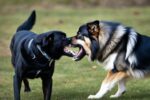Addressing Food Aggression in Dogs

Food aggression in dogs can be a serious problem that requires behavior therapy and management techniques to ensure the safety and well-being of both the dog and the household. Food aggression is a form of resource guarding where dogs become defensive and display threatening behavior to protect their food. This behavior can pose risks to other dogs or humans in the home and may range from mild growling to severe biting.
Food aggression is not solely driven by dominance but is also rooted in inherited pack behavior and the instinct to guard food as a survival mechanism. Recognizing the signs of food aggression, such as stiffening of the body, lowered head, and raised hackles, is crucial in addressing the issue effectively. Understanding the severity of the aggression and assessing the overall behavior and confidence of the dog are important factors in implementing appropriate strategies for managing food aggression.
In the following sections, we will explore the causes and signs of food aggression in dogs, effective strategies for managing this behavior, as well as prevention techniques and long-term solutions to ensure a harmonious environment for everyone in the household.
Understanding the Causes and Signs of Food Aggression
Food aggression in dogs can have various causes, including learned behavior in puppyhood, traumatic experiences, genetic factors in certain breeds, and competition over limited resources in shelter environments.
It is important to recognize the signs of food aggression, which can be categorized into mild, moderate, and severe degrees of aggression. Mild signs may include growling, baring teeth, or raising hackles, while moderate signs involve snapping or lunging. Severe food aggression can result in biting and chasing away perceived threats. Recognizing these signs is crucial to address and manage food aggression in dogs.
“The key to effectively addressing food aggression in dogs is to understand the underlying causes and to identify the specific signs exhibited by the dog,” says Dr. Emily Miller, a renowned veterinarian specializing in canine behavior.
Causes of Food Aggression
Food aggression can stem from various factors, including:
- Learned behavior in puppyhood
- Traumatic experiences
- Genetic predisposition in certain breeds
- Competition over limited resources in shelter environments
Signs of Food Aggression
The signs of food aggression can range from subtle to overt displays of aggression. Understanding and recognizing these signs is crucial for effective intervention. Here are common signs:
- Mild signs:
- Growling
- Baring teeth
- Raising hackles
- Moderate signs:
- Snapping
- Lunging
- Severe signs:
- Biting
- Chasing away perceived threats
“It is important not to underestimate even the mildest signs of food aggression, as they can escalate if left unaddressed,” advises Dr. Miller.
Effective Strategies for Managing Food Aggression
When it comes to managing food aggression in dogs, there are several effective strategies that can be implemented. These strategies aim to address the underlying behavior issues and create a positive environment during mealtimes. By following these strategies, dog owners can help their furry friends overcome food aggression and develop healthier behaviors.
1. Establish a Consistent Feeding Routine
One of the fundamental strategies in managing food aggression is establishing a consistent feeding routine. This routine helps reduce anxiety and creates a sense of predictability for the dog. By feeding them at the same time every day and in the same location, the dog becomes familiar with the routine and feels more secure during mealtimes.
2. Utilize Training Techniques
Training techniques such as treating tossing, hand-feeding, and “trade-up” can be highly effective in reconditioning dogs with food aggression. Treating tossing involves tossing treats near the dog’s food bowl to create positive associations with people approaching their food. Hand-feeding and “trade-up” techniques encourage the dog to view human presence near their food as a positive experience rather than a threat.
3. Desensitization and Counterconditioning
Desensitization and counterconditioning are key components of behavior therapy for food aggression. This program consists of seven stages that focus on gradually exposing the dog to human presence during mealtime while reinforcing positive associations. Each stage should be completed with the dog showing no aggression before progressing to the next stage. This program can be highly effective in reducing food aggression over time.
“Desensitization and counterconditioning programs are highly effective in helping dogs overcome their food aggression. By gradually exposing the dog to the trigger and reinforcing positive associations, we can reshape their behavior and create a more harmonious feeding experience.” – Dr. Anna Thompson, Animal Behavior Specialist
4. Seek Professional Help if Needed
While managing food aggression can be achieved through these strategies, severe cases may require the expertise of a professional. A veterinarian or certified dog behaviorist can provide personalized guidance and develop a tailored behavior therapy plan to address the specific needs of the dog. Seeking professional help ensures that the dog’s well-being is prioritized and that appropriate interventions are implemented.
By implementing these strategies, dog owners can effectively manage and ultimately overcome food aggression in their furry companions. Consistency, patience, and professional guidance are key to achieving long-term behavior changes and providing a safe and peaceful feeding environment.
| Strategies | Benefits |
|---|---|
| Establish a Consistent Feeding Routine | – Reduces anxiety and promotes a sense of security – Establishes a predictable environment for the dog |
| Utilize Training Techniques | – Creates positive associations with humans near the food – Encourages the dog to view human presence as non-threatening |
| Desensitization and Counterconditioning | – Gradually exposes the dog to human presence during mealtime – Reinforces positive associations with human interactions |
| Seek Professional Help if Needed | – Provides personalized guidance and behavior therapy – Ensures the well-being of the dog and appropriate interventions |
Preventing and Achieving Long-Term Solutions for Food Aggression
To prevent food aggression in dogs and achieve long-term solutions, it is crucial to implement proper training and management techniques. By addressing this issue proactively, you can create a harmonious environment for both your dog and those living in your household.
One effective method for preventing food aggression is spaying or neutering your dog. This procedure can help reduce aggression caused by hormones, promoting a calmer and more balanced temperament.
Establishing a consistent feeding routine is another essential step. By feeding your dog at the same time every day, you establish a sense of security and predictability. This can reduce anxiety and prevent resource guarding behavior.
During mealtime, it is important to stay in the room with your dog. This presence helps reinforce positive associations with you being near their food. In time, your dog will come to understand that your presence during mealtime is not a threat.
Gradually increasing proximity and interaction during mealtimes can help desensitize your dog to human presence and promote trust. Start by standing near your dog while they eat, then progress to sitting next to them, and eventually touching their bowl or gently stroking them. This gradual approach allows your dog to become comfortable with your presence and reduces the likelihood of food aggression.
Seeking professional assistance, such as consulting a veterinarian or trainer, may be necessary for more severe cases of food aggression. These experts can provide guidance tailored to your specific situation and help you address the issue effectively.
Throughout the process, it is important to be patient, consistent, and observant of your dog’s body language. Recognizing any signs of discomfort or aggression allows you to adjust your approach and ensure a safe training environment.
Key Strategies for Preventing Food Aggression:
- Spay or neuter your dog to reduce aggression caused by hormones.
- Create a consistent feeding routine to establish a sense of security.
- Stay in the room with your dog during mealtime to reinforce positive associations.
- Gradually increase proximity and interaction during mealtimes to desensitize the dog to human presence and promote trust.
- Seek professional assistance for more severe cases of food aggression.
| Benefits of Preventing Food Aggression | Effective Strategies |
|---|---|
|
|
Conclusion
Addressing and managing food aggression in dogs is crucial for maintaining a safe and harmonious environment for both the dog and the household. By recognizing the causes and signs of food aggression, pet owners can implement effective strategies to manage and prevent this behavior. Behavior therapy techniques, such as desensitization and counterconditioning, combined with consistent training, can help address food aggression and potentially eliminate it in the long term.
Seeking professional help when necessary is essential for dealing with severe cases of food aggression. Veterinarians and trainers can provide guidance and support in implementing behavior therapy programs tailored to the dog’s needs. Additionally, maintaining a safe and consistent feeding routine is key to preventing food aggression. This includes implementing a feeding schedule, staying present during mealtime, and gradually increasing proximity and interaction with the dog.
By addressing food aggression through behavior therapy and prevention methods, pet owners can create a secure environment and ensure the well-being of their dogs and those around them. Managing food aggression not only guarantees the safety of humans and other animals in the household but also promotes a trusting and peaceful relationship between pet and owner.
FAQ
What is food aggression in dogs?
Food aggression in dogs is a form of resource guarding where dogs become defensive and resort to threats to protect their food. It can range from mild growling to severe biting.
What are the causes and signs of food aggression in dogs?
Food aggression in dogs can be caused by learned behavior, traumatic experiences, genetic factors, and competition over resources. Signs can include growling, snapping, lunging, and biting.
How can I manage food aggression in my dog?
Strategies for managing food aggression include establishing a consistent feeding routine, using training techniques like hand-feeding and “trade-up,” and employing desensitization and counterconditioning programs.
How can I prevent food aggression in my dog?
Preventing food aggression in dogs involves creating a consistent feeding routine, gradually increasing proximity and interaction during mealtimes, and seeking professional help if needed.
Why is addressing food aggression important?
Addressing and managing food aggression in dogs is essential for the safety and well-being of both the dog and those living in the household.








